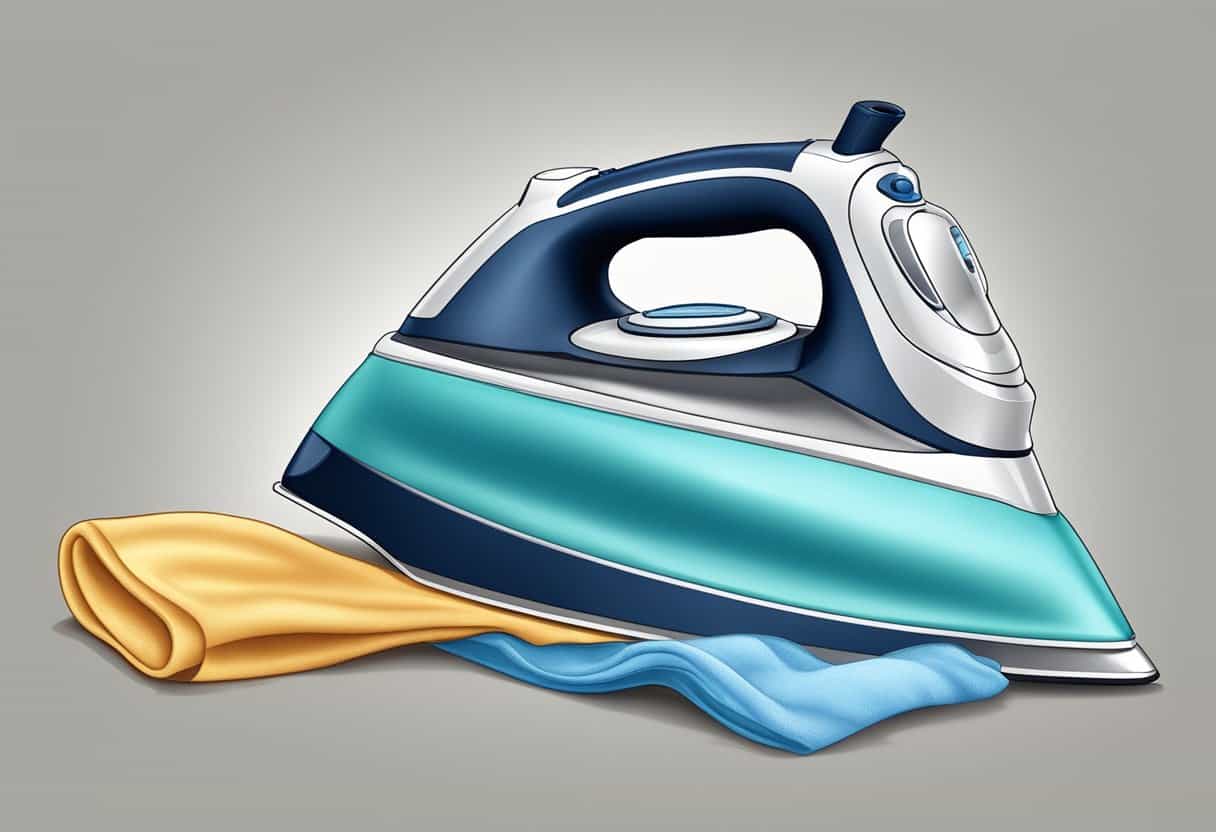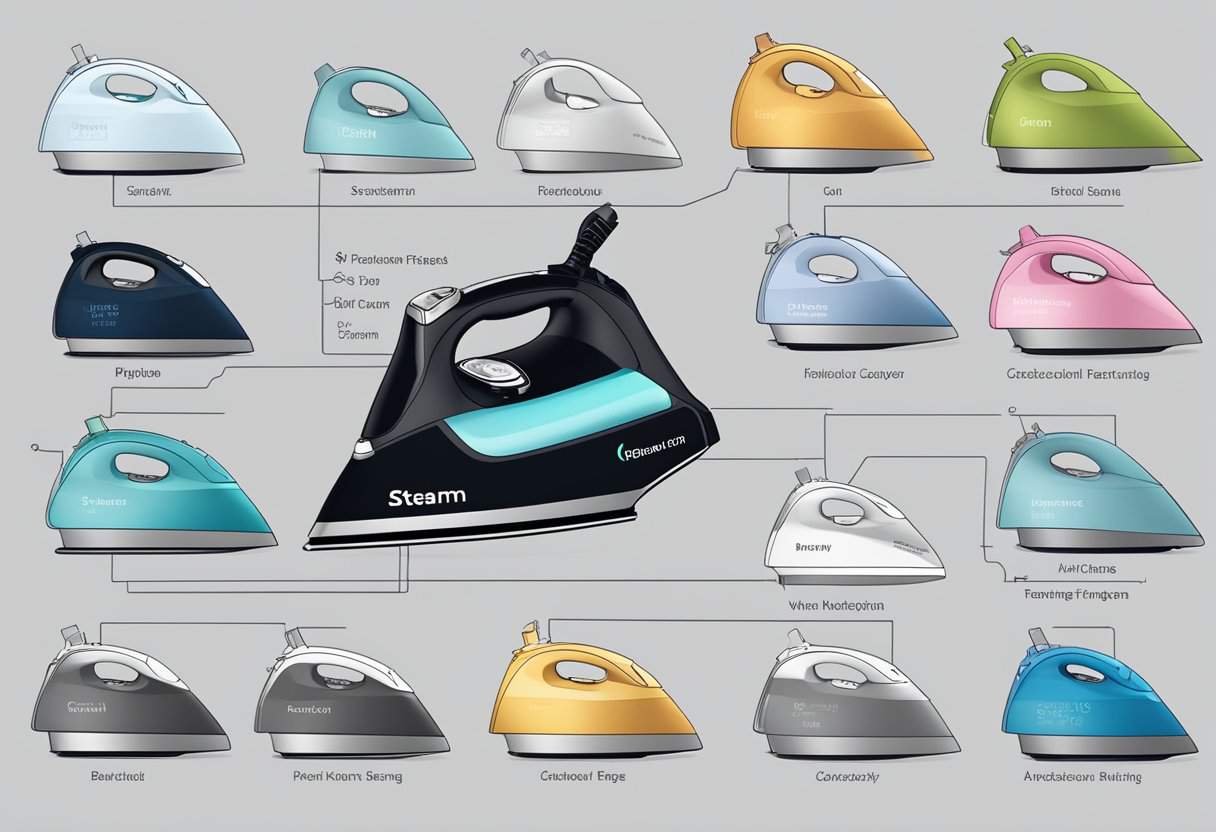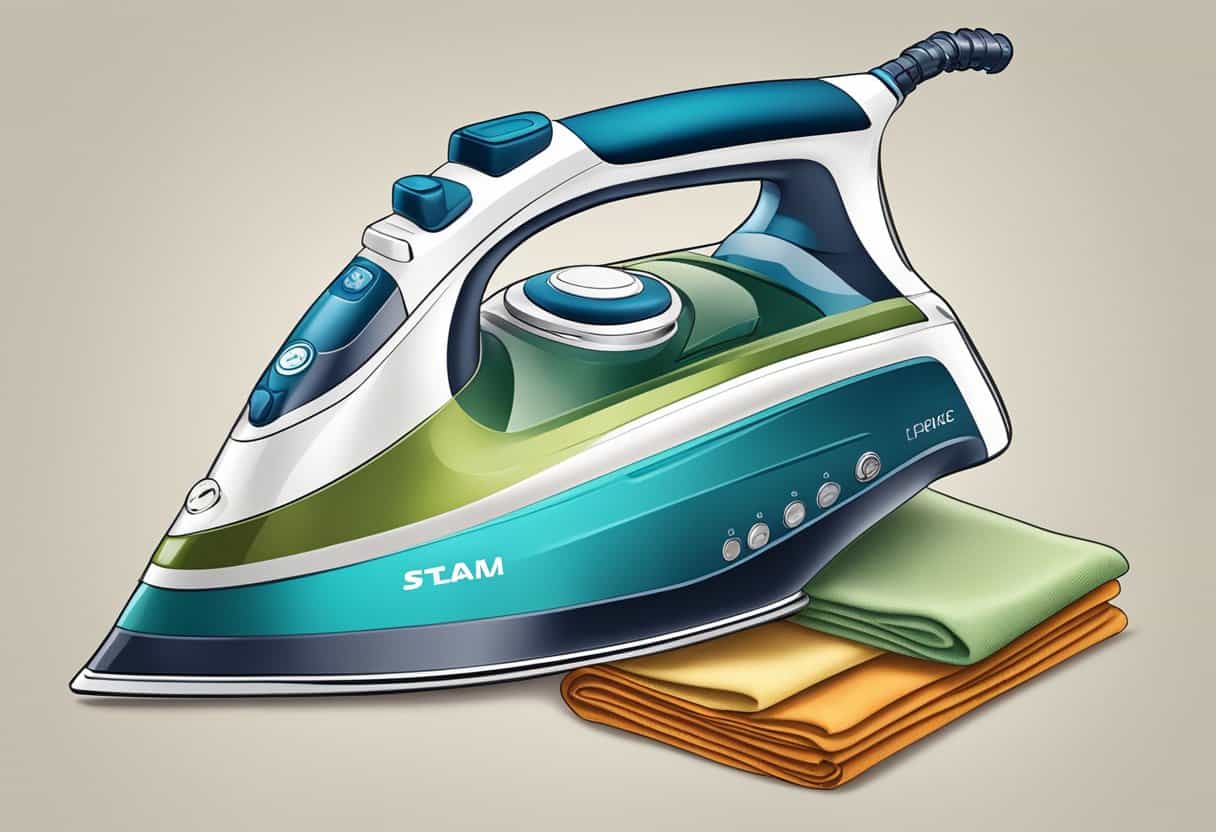Steam iron technology has evolved to incorporate various features that enhance your ironing experience. Your steam iron likely includes a water tank, which is used to store water that is heated to produce steam. The steam is then expelled through the soleplate’s holes to relax fabric fibers and remove wrinkles effectively.
Key components:
- Soleplate: Your iron’s soleplate is the flat, triangular metal base that heats up and presses against your clothes. It usually features a non-stick coating to glide smoothly over fabrics.
- Steam Vents: These small holes distributed across the soleplate emit steam during ironing.
- Temperature Control: This allows you to adjust the heat setting according to the type of fabric you’re ironing.
- Steam Burst Button: A feature that delivers an extra burst of steam for tough wrinkles, often located on the iron’s handle.
| Fabric | Temperature Setting | Steam Setting |
|---|---|---|
| Linen | High | High |
| Cotton | High | Medium to High |
| Wool | Medium | Low to Medium |
| Silk | Low | Low |
| Synthetic | Low | Low |
Ensure you always check the label on your garments for the manufacturer’s recommended ironing settings, as using incorrect heat and steam levels can damage the fabric.
Modern steam irons may also come with a self-cleaning system that removes mineral deposits to maintain the iron’s performance and prolong its life. Some models include other thoughtful additions, such as auto-shutoff for safety and digital displays for precise control.
Fabric Types and Recommended Settings
When ironing, it’s crucial to match the proper settings to the appropriate fabric types to ensure effective and safe care.
Cotton and Linen
For Cotton and Linen, which can withstand high heat, set your steam iron to a high temperature. Use the cotton or linen setting, typically indicated by ••• or a similar symbol. If your items are particularly delicate or have embellishments, reduce the heat slightly and consider using a pressing cloth to protect the fabric.
| Fabric | Temperature Setting | Steam Option |
|---|---|---|
| Cotton | High (•••) | Yes |
| Linen | High (•••) | Yes |
Wool and Silk
Wool requires a medium setting, often denoted by ••, as it is sensitive to heat. Always use steam and consider a pressing cloth to avoid shine. For Silk, use a low to medium heat setting (•) and minimal steam to prevent water marks. Silk is very delicate, so you may prefer to press the iron gently onto the fabric rather than glide it across.
| Fabric | Temperature Setting | Steam Option |
|---|---|---|
| Wool | Medium (••) | Yes |
| Silk | Low to Medium (•) | Minimal Steam |
Synthetics
Synthetics such as Polyester, Nylon, and Acrylic require low heat settings, represented by • or a synthetic setting on your iron. These materials can melt or become shiny if the iron is too hot. Use a light steam setting or none at all and consider a protective cloth.
| Fabric | Temperature Setting | Steam Option |
|---|---|---|
| Polyester | Low (•) | Light or None |
| Nylon | Low (•) | None |
| Acrylic | Low (•) | None |
The Functions of Steam in Ironing

Steam plays a crucial role in ironing by utilizing heat and moisture to relax fabric fibers. This leads to easier crease removal and a better finish. Below are the primary functions of steam in the ironing process:
- Moisture Addition: Steam adds moisture to the fibers, making them more pliable. When you press the hot iron against the fabric, the steam penetrates the material, allowing for easier smoothing of wrinkles.
- Heat Distribution: The steam equally distributes heat over the fabric surface, ensuring consistent ironing results.
- Crease Removal Efficiency: Steam helps to efficiently remove stubborn creases, which might be difficult to eliminate with a dry iron.
When using steam, adjust the settings according to the type of fabric:
| Fabric Type | Iron Setting |
|---|---|
| Linen | High |
| Cotton | High |
| Wool | Medium |
| Polyester | Low |
| Silk | Low |
- Vertical Steaming: Some irons offer vertical steaming, allowing you to remove wrinkles from hanging garments or drapes without an ironing board.
Remember that delicate fabrics may require a pressing cloth to prevent water spots or damage. Always check garment care tags for proper instructions. Steam can provide professional results when you use the correct settings for your fabrics.
Advanced Features of Modern Steam Irons

Modern steam irons are equipped with a variety of advanced features designed to provide you with superior ironing results and greater convenience. These features are specifically crafted to tackle different fabrics and ironing challenges efficiently.
Precision Tips and Soleplates
Your steam iron’s precision tip allows you to reach difficult areas, such as around buttons and along seams, to ensure a crisp finish. The carefully engineered soleplates are often made from high-grade materials like ceramic or stainless steel, offering a smooth glide over any fabric type. Look for a non-stick coating and even heat distribution to protect your garments and reduce the risk of scorching.
Steam Bursts and Vertical Steaming
The steam burst function on your iron provides a powerful shot of steam to handle deep wrinkles and stubborn creases. This can be activated with a simple button push, releasing a high steam output for a limited time. In addition, vertical steaming capabilities enable you to de-wrinkle hanging garments or curtains without an ironing board, enhancing the versatility of your steam iron.
Adjustable Thermostats and Anti-Drip Systems
Adjustable thermostats give you the control to set the precise temperature needed for each fabric type, from delicate silks to durable cottons. This helps in preventing heat damage. Modern steam irons also come with anti-drip systems which prevent water leakage at lower temperatures, ensuring your clothes remain spot-free during the ironing process.
Maintenance and Troubleshooting

Proper maintenance ensures longevity of your steam iron, while troubleshooting common issues can save you time and money.
Cleaning and Descaling
Your steam iron requires regular cleaning to prevent mineral buildup. For cleaning, use a damp cloth to wipe the body and soleplate, avoiding harsh chemicals. For descaling, which unclogs steam vents:
- Fill the reservoir with a mixture of half distilled water and half white vinegar.
- Set the iron to steam mode and leave it upright for 30 minutes.
- Empty the reservoir and fill it with fresh distilled water.
- Steam an old cloth to clear out any remaining vinegar solution.
Common Issues and Solutions
Here is a list of common issues with corresponding solutions:
| Issue | Solution |
|---|---|
| Water Leaking | Check for overfilling and ensure your iron is not too cool for steam setting. |
| Soleplate Stains | Gently scrub with a baking soda paste; for sticky residues, use a damp cloth with a bit of salt. |
| Steam Not Working | Descale the iron. If the issue persists, check for internal blockages and consult the manual or a professional. |
| Temperature Inconsistency | Verify the temperature setting matches the fabric type. If settings are correct but the issue remains, the thermostat may need replacing. |
For optimal performance, empty the water reservoir after each use, and store the iron in an upright position to avoid leakage. Regular maintenance and addressing issues promptly can greatly extend the life of your steam iron.
Safety Tips for Using Steam Irons

When using steam irons, safety is paramount to prevent accidents and injuries. Always read the manufacturer’s manual before using your steam iron to understand its specific safety features and requirements.
Set Up Properly: Ensure that your ironing board is stable and that the iron is placed on a solid, heat-resistant surface when not in use. Keep the cord away from the edges to avoid tripping or pulling the iron off the surface.
Correct Temperature: Use the appropriate temperature setting for different fabrics. For example:
| Fabric Type | Temperature Setting |
|---|---|
| Linen | High |
| Cotton | Medium to High |
| Wool | Medium |
| Synthetic | Low to Medium |
Water for Steam: Use distilled or demineralized water if recommended by the manufacturer to prevent mineral build-up. Never overfill the water tank.
Iron in Motion: Keep the iron moving while in contact with fabric to prevent scorching. If you must leave the iron unattended, even briefly, place it upright or secure it in its holder.
Children and Pets: Keep both out of the ironing area. The cord should not dangle where they could pull it.
Storage: Allow the iron to cool completely before storing. Empty the water reservoir to prevent leaks and potential damage to the iron.
Wear Protection: Consider using protective garments or gloves to safeguard against steam burns, especially when ironing for extended periods.
By following these guidelines, you can ensure a safe ironing experience that protects both you and your garments.

